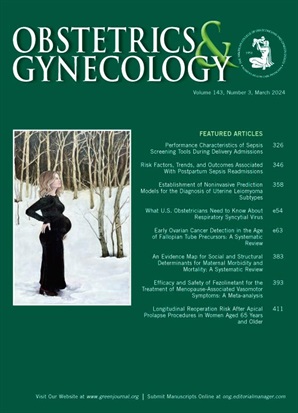中心性肥胖和全身性肥胖与盆腔器官脱垂的关系
IF 4.7
2区 医学
Q1 OBSTETRICS & GYNECOLOGY
引用次数: 0
摘要
目的:研究中心性肥胖和全身性肥胖的综合指标与盆腔器官脱垂(POP)风险之间的关系。方法:2006 年至 2010 年间,在英国生物库(UK Biobank)注册时收集了 251,143 名未患 POP 的参与者(年龄 39-71 岁)的腰围/身高比和体重指数(BMI,以体重(公斤)除以身高(米)的平方计算)。对参与者的随访至 2022 年 12 月 19 日。通过病历中的《国际疾病分类》第十版代码和手术程序代码确定发病的 POP。采用 Cox 比例危险模型来估算肥胖指标与发病 POP 之间的关系。结果在中位 13.8 年的随访期间,共记录了 9781 例 POP 病例。无论体重指数如何,中心性肥胖(腰围/身高比大于或等于 0.5)与 POP 风险增加 48% 相关(危险比 [HR] 1.48;95% CI,1.41-1.56)。在所有 POP 病例中,约有 21.7%(95% CI,19.1-24.4%)的病例可归因于中心性肥胖。此外,无中心性肥胖的超重(体重指数 25-29.9 且腰围/身高比小于 0.5)与 POP 风险增加 23% 相关(HR 1.23;95% CI,1.14-1.34),占所有 POP 病例的 2.0%(95% CI,1.1-2.9%)。与中心性肥胖相关的 POP 风险增加的程度因年龄(60 岁以下 vs 60 岁或以上:57% vs 39%)和子宫切除史(无 vs 有:54% vs 27%)而异。本文章由计算机程序翻译,如有差异,请以英文原文为准。
Association of Central and General Obesity Measures With Pelvic Organ Prolapse.
OBJECTIVE
To examine the association between the combination of central and general obesity measures and the risk of pelvic organ prolapse (POP).
METHODS
Waist/height ratio and body mass index (BMI, calculated as weight in kilograms divided by height in meters squared) for 251,143 participants (aged 39-71 years) without pre-existing POP from the UK Biobank were collected at enrollment between 2006 and 2010. Participants were followed through December 19, 2022. Incident POP was identified using International Classification of Diseases, Tenth Revision codes and operating procedure codes in the medical records. Cox proportional hazards model was used to estimate the association between obesity measures and incident POP. Population-attributable fractions were calculated to indicate the proportion of cases that were attributable to obesity measures.
RESULTS
During a median follow-up of 13.8 years, 9,781 POP cases were recorded. Central obesity (waist/height ratio 0.5 or greater) was associated with a 48% increased risk of POP regardless of BMI (hazard ratio [HR] 1.48; 95% CI, 1.41-1.56). Approximately 21.7% (95% CI, 19.1-24.4%) of all POP cases were attributable to central obesity. In addition, overweight without central obesity (BMI 25-29.9 and waist/height ratio less than 0.5) was associated with a 23% higher risk of POP (HR 1.23; 95% CI, 1.14-1.34), and this accounted for 2.0% (95% CI, 1.1-2.9%) of all POP cases. The magnitude of increased POP risk associated with central obesity varied by age (younger than 60 years vs 60 years or older: 57% vs 39%) and by history of hysterectomy (no vs yes: 54% vs 27%).
CONCLUSION
Central obesity and overweight without central obesity are risk factors for POP.
求助全文
通过发布文献求助,成功后即可免费获取论文全文。
去求助
来源期刊

Obstetrics and gynecology
医学-妇产科学
CiteScore
11.10
自引率
4.20%
发文量
867
审稿时长
1 months
期刊介绍:
"Obstetrics & Gynecology," affectionately known as "The Green Journal," is the official publication of the American College of Obstetricians and Gynecologists (ACOG). Since its inception in 1953, the journal has been dedicated to advancing the clinical practice of obstetrics and gynecology, as well as related fields. The journal's mission is to promote excellence in these areas by publishing a diverse range of articles that cover translational and clinical topics.
"Obstetrics & Gynecology" provides a platform for the dissemination of evidence-based research, clinical guidelines, and expert opinions that are essential for the continuous improvement of women's health care. The journal's content is designed to inform and educate obstetricians, gynecologists, and other healthcare professionals, ensuring that they stay abreast of the latest developments and best practices in their field.
 求助内容:
求助内容: 应助结果提醒方式:
应助结果提醒方式:


